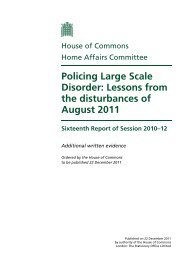A gap or a chasm? - National Police Library Online Catalogue
A gap or a chasm? - National Police Library Online Catalogue
A gap or a chasm? - National Police Library Online Catalogue
Create successful ePaper yourself
Turn your PDF publications into a flip-book with our unique Google optimized e-Paper software.
A <strong>gap</strong> <strong>or</strong> a <strong>chasm</strong>? Attrition in rep<strong>or</strong>ted rape cases<br />
30<br />
s t ronger impacts were found adjusting the methodology and looking at three states (Bachman<br />
and Smith, 1994) but the higher attrition rate compared to other serious crimes persisted.<br />
The Senate Judiciary Committee issued a rep<strong>or</strong>t entitled Detours on the Road to Equal Justice<br />
in 1993 that documented attrition in rape cases across the USA. The average conviction<br />
rate in 1990 was 12 per cent. The rep<strong>or</strong>t demonstrates disparities in how rape and other<br />
violent crimes were prosecuted. The key Attrition points identified were: arrest (62% of<br />
rep<strong>or</strong>ted rapes do not result in an arrest); dismissal (of the cases that moved into the system,<br />
48% were dismissed bef<strong>or</strong>e trial); and acquittal at trial. The committee also noted reluctance<br />
amongst prosecut<strong>or</strong>s to bring cases where the parties were known to one another – the<br />
maj<strong>or</strong>ity of rape cases. However, the review found significantly higher conviction rates in<br />
particular areas of the US, including Washington and New Y<strong>or</strong>k. A subsequent review notes<br />
that conviction rates across the USA range from 2.5 to 19.9 per cent (Sinclair and Bourne,<br />
1998, p576) but offered little explanation of these wide discrepancies.<br />
B re reton (1993) discusses four Australian studies where patterns similar to those<br />
documented f<strong>or</strong> England and Wales and the USA are re p o rted. The key players are the<br />
victim, in terms of the decision to rep<strong>or</strong>t and continuing with the case, and the police in<br />
terms of the decision of whether to lay charges and their influence on the victim’s subsequent<br />
decision-making. Several studies also note 20 to 35 per cent of cases being dropped by<br />
prosecut<strong>or</strong>s. Guilty pleas are much lower than in other criminal cases. Two fact<strong>or</strong>s had the<br />
most impact on outcomes at trial: evidence of physical injury; and admissions by the<br />
defendant at some point in the process.<br />
Identifying Attrition points<br />
Attrition research identifies a paradox internationally: despite widespread ref<strong>or</strong>m of statute<br />
law and, in many jurisdictions, procedural rules, the 1990s witnessed declining <strong>or</strong> static<br />
conviction rates. The UK has one of the most pronounced patterns. Remarkably little<br />
re s e a rch <strong>or</strong> legal commentary has, as yet, attempted to explain these common – and<br />
unexpected – international similarities.<br />
R e s e a rch to date in adversarial legal systems has identified four key points at which attrition<br />
occurs. The first point is the decision to re p o rt itself; estimates of the re p o rting rate range from 5<br />
to 25 per cent. Even using the highest re p o rting rate estimate, thre e - q u a rters of cases never<br />
reach the first hurdle within the CJS. The second involves the police investigation stage – the<br />
initial response, f<strong>or</strong>ensic examination, statement taking, evidence gathering and arrest and/<strong>or</strong><br />
i n t e rviewing of suspects – between half and thre e - q u a rters of re p o rted cases are lost here. The

















